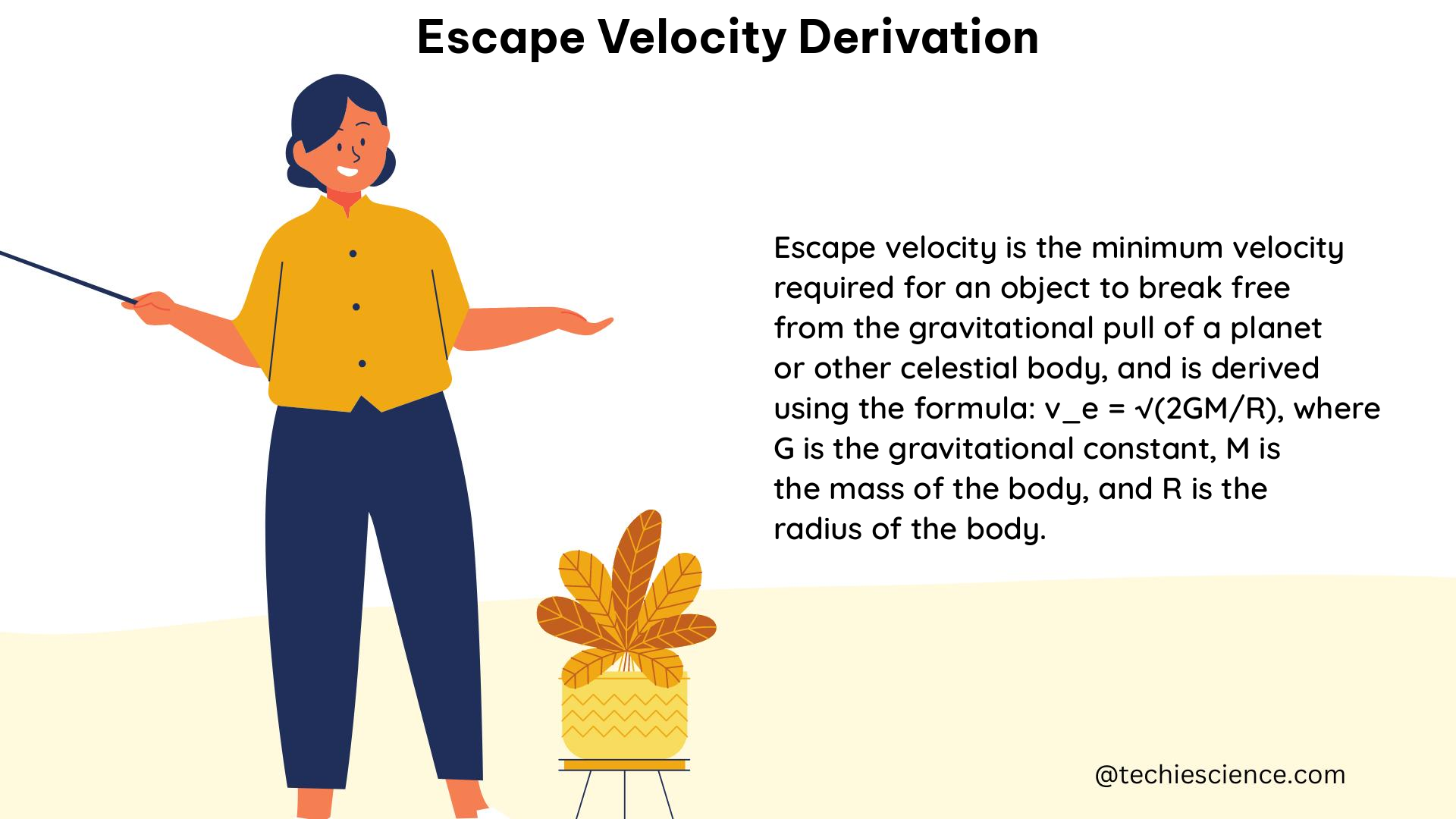Escape velocity is the minimum velocity required for an object to escape a planet’s gravitational pull and move into space. This crucial concept in physics can be derived using the principle of conservation of energy and the formulae for kinetic and gravitational potential energy. The escape velocity (ve) can be calculated using the formula ve=√2GM/R, where G is the gravitational constant, M is the mass of the planet, and R is the radius of the planet.
Understanding the Principle of Conservation of Energy
The derivation of escape velocity is based on the principle of conservation of energy. This principle states that the total energy of an isolated system is constant; it is the sum of the kinetic energy and the potential energy of the system, and this sum does not change unless energy is transferred into or out of the system.
In the case of an object escaping a planet’s gravitational field, the total energy of the object is the sum of its kinetic energy and its gravitational potential energy. The object must have enough kinetic energy to overcome the gravitational potential energy and escape the planet’s gravitational pull.
Formulae for Kinetic and Gravitational Potential Energy

The kinetic energy (KE) of an object is given by the formula:
KE = 1/2 * m * v^2
where m is the mass of the object and v is its velocity.
The gravitational potential energy (GPE) of an object near the surface of a planet is given by the formula:
GPE = -G * M * m / R
where G is the gravitational constant, M is the mass of the planet, m is the mass of the object, and R is the radius of the planet.
Derivation of Escape Velocity
To derive the escape velocity, we can use the principle of conservation of energy. At the point of escape, the total energy of the object must be zero, as it has just enough energy to overcome the planet’s gravitational pull and move into space.
The total energy (E) of the object is the sum of its kinetic energy and gravitational potential energy:
E = KE + GPE
E = 1/2 * m * v^2 – G * M * m / R
At the point of escape, the total energy must be zero:
0 = 1/2 * m * v^2 – G * M * m / R
v^2 = 2 * G * M / R
Taking the square root of both sides, we get the formula for escape velocity:
ve = √(2 * G * M / R)
This formula shows that the escape velocity depends on the gravitational constant (G), the mass of the planet (M), and the radius of the planet (R).
Example Calculation: Earth’s Escape Velocity
Let’s calculate the escape velocity for Earth using the formula:
ve = √(2 * G * M / R)
Where:
– G = 6.67 × 10^-11 N⋅m^2/kg^2 (gravitational constant)
– M = 5.97 × 10^24 kg (mass of Earth)
– R = 6.37 × 10^6 m (radius of Earth)
Plugging in the values, we get:
ve = √(2 * 6.67 × 10^-11 N⋅m^2/kg^2 * 5.97 × 10^24 kg / 6.37 × 10^6 m)
ve = √(2 * 39.8 × 10^13 m^2/s^2)
ve = √(79.6 × 10^13 m^2/s^2)
ve = 11.2 km/s
Therefore, the escape velocity of Earth is approximately 11.2 km/s.
Advanced Derivations and Applications
In addition to the basic derivation, there are more complex derivations and applications of escape velocity:
-
Schwarzschild Radius: The Schwarzschild radius is the radius at which the escape velocity equals the speed of light. This is the radius of a black hole, beyond which nothing, not even light, can escape.
-
Escape Velocity for Black Holes: The escape velocity for a black hole is equal to the speed of light, as nothing can escape from within the Schwarzschild radius.
-
Escape-Velocity Suppression in Clusters: To quantify the escape-velocity suppression in a cluster, a factor Zv can be introduced, which is the amount by which the 3D radial escape velocity (vesc) is suppressed in order to produce the observed maximum velocity vesc,los. This can be used to determine the amount of projected escape-edge suppression in a densely sampled phase space, such as that of dark matter particles.
-
Escape Velocity and Orbital Mechanics: Escape velocity is a crucial concept in the study of celestial mechanics and the behavior of objects in space, as it determines the minimum velocity required for an object to escape a planet’s gravitational pull and enter a different orbit or escape the planet entirely.
Conclusion
Escape velocity is a fundamental concept in physics that has numerous applications in the study of celestial mechanics and the behavior of objects in space. By understanding the derivation of escape velocity using the principle of conservation of energy and the formulae for kinetic and gravitational potential energy, we can gain insights into the behavior of objects in gravitational fields and the properties of celestial bodies.
References
- Derivation of Escape Velocity
- Gravitational Field and Potential, Escape Velocity, Universal Gravitational Law, Radial and Transverse Velocity and Acceleration with Derivation and Examples
- Escape-Velocity Suppression in Clusters
- Doubt Regarding Derivation of Escape Velocity
- Escape Velocity Derivation and Explanation

The lambdageeks.com Core SME Team is a group of experienced subject matter experts from diverse scientific and technical fields including Physics, Chemistry, Technology,Electronics & Electrical Engineering, Automotive, Mechanical Engineering. Our team collaborates to create high-quality, well-researched articles on a wide range of science and technology topics for the lambdageeks.com website.
All Our Senior SME are having more than 7 Years of experience in the respective fields . They are either Working Industry Professionals or assocaited With different Universities. Refer Our Authors Page to get to know About our Core SMEs.